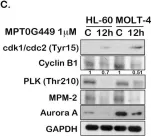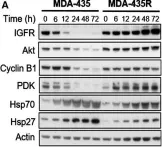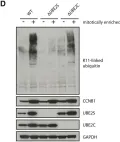17β-estradiol (E2), the main circulating estrogen hormone, is a critical signaling factor for the growth, differentiation, and function of breast epithelial cells. The effects of E2 on the breast tissue are primarily mediated by the estrogen receptor α (ERα). Deregulation of the E2-ERα signaling contributes to the initiation/progression of breast cancer and resistance to treatments. Cell lines from breast adenocarcinomas as in vitro model systems provide invaluable insight into cellular events, drug discovery, and drug resistance. Among ERα-synthesizing cell lines, MCF7 and T47D cells are widely used to elucidate cell cycle phase-specific molecular events that coordinate cellular proliferation mediated by E2-ERα. Due to variable results in generating phase-enriched populations with various approaches, we wanted to reassess cell cycle synchronization-coupled phase enrichment with charcoal dextran-treated fetal bovine serum, CD-FBS, as an effective hormone withdrawal approach, alone or in combination with excess thymidine, as a DNA replication inhibitor, and/or nocodazole, a microtubule poison, in MCF7 and T47D cells. We find that hormone withdrawal synchronizes both MCF7 and T47D cells at the G0/G1 phase. Supplementation of CD-FBS with E2 enriches the S phase population. E2 with nocodazole and nocodazole-coupled mitotic shake-off augments the G2/M phase population of MCF7 cells. However, the double thymidine block approach with nocodazole or nocodazole-coupled mitotic shake-off is more effective in enriching S and G2/M phase populations of T47D cells. Our results highlight the differential efficacy of synchronization approaches in MCF7 and T47D cells that could provide a framework for cell cycle-specific applications in breast cancer research.
© 2025. The Author(s).
Product Citations: 26
In Scientific Reports on 18 February 2025 by Toker, P., Ayten, H., et al.
-
Endocrinology and Physiology
SART1 modulates poly-(ADP-ribose) chain accumulation and PARP1 chromatin localization.
In IScience on 15 November 2024 by Lodovichi, S., Nepomuceno, T. C., et al.
PARP1 inhibitors (PARPis) are used for treatment of cancers with mutations in BRCA1 or BRCA2 that are deficient in homologous recombination. The identification of modulators of PARP1 activity is critical to understand and overcome resistance to PARPis. We integrated data from three omics-scale screens to discover new regulators of PARP1 activity. We identified SART1 and show that its silencing leads to an increase in poly-ADP ribosylation and chromatin-bound PARP1. SART1 is recruited to chromatin following DNA damage and limits PARP1 chromatin retention and activity. The SART1 N-terminus is sufficient to regulate the accumulation of PAR chains and PARP1 on chromatin, an activity dependent on the RGG/RG box. Silencing of SART1 leads to an increased sensitivity of cells to DNA damage induced by IR, irrespective of BRCA1 status and to PARPis only in absence of BRCA1. These results suggest that SART1 could be clinically utilized to improve PARPi efficacy.
© 2024 The Author(s).
-
ICC-IF
FBXW7-loss Sensitizes Cells to ATR Inhibition Through Induced Mitotic Catastrophe.
In Cancer Res Commun on 21 December 2023 by O'Brien, S., Ubhi, T., et al.
FBXW7 is a commonly mutated tumor suppressor gene that functions to regulate numerous oncogenes involved in cell-cycle regulation. Genome-wide CRISPR fitness screens identified a signature of DNA repair and DNA damage response genes as required for the growth of FBXW7-knockout cells. Guided by these findings, we show that FBXW7-mutant cells have high levels of replication stress, which results in a genotype-specific vulnerability to inhibition of the ATR signaling pathway, as these mutant cells become heavily reliant on a robust S-G2 checkpoint. ATR inhibition induces an accelerated S-phase, leading to mitotic catastrophe and cell death caused by the high replication stress present in FBXW7-/- cells. In addition, we provide evidence in cell and organoid studies, and mining of publicly available high-throughput drug screening efforts, that this genotype-specific vulnerability extends to multiple types of cancer, providing a rational means of identifying responsive patients for targeted therapy.
We have elucidated the synthetic lethal interactions between FBXW7 mutation and DNA damage response genes, and highlighted the potential of ATR inhibitors as targeted therapies for cancers harboring FBXW7 alterations.
© 2023 The Authors; Published by the American Association for Cancer Research.
-
Homo sapiens (Human)
-
Cell Biology
Mitotic phosphorylation inhibits the Golgi mannosidase MAN1A1.
In Cell Reports on 22 November 2022 by Huang, S., Haga, Y., et al.
N-glycans are processed mainly in the Golgi, and a well-organized Golgi structure is required for accurate glycosylation. However, during mitosis the Golgi undergoes severe fragmentation. The resulting trafficking block leads to an extended exposure of cargo molecules to Golgi enzymes. It is unclear how cells avoid glycosylation defects during mitosis. In this study, we report that Golgi α-1,2-mannosidase IA (MAN1A1), the first enzyme that cargo proteins encounter once arriving the Golgi, is phosphorylated at serine 12 by CDK1 in mitosis, which attenuates its activity, affects the production of glycan isomers, and reduces its interaction with the subsequent glycosyltransferase, MGAT1. Expression of wild-type MAN1A1, but not its phosphomimetic mutant, rescues the glycosylation defects in mannosidase I-deficient cells, whereas expression of its phosphorylation-deficient mutant in mitosis increases the formation of complex glycans. Our study reveals that glycosylation is regulated by cytosolic signaling during the cell cycle.
Copyright © 2022 The Author(s). Published by Elsevier Inc. All rights reserved.
-
Cell Biology
Tight association of autophagy and cell cycle in leukemia cells.
In Cellular Molecular Biology Letters on 5 April 2022 by Gschwind, A., Marx, C., et al.
Autophagy plays an essential role in maintaining cellular homeostasis and in the response to cellular stress. Autophagy is also involved in cell cycle progression, yet the relationship between these processes is not clearly defined.
In exploring this relationship, we observed that the inhibition of autophagy impaired the G2/M phase-arresting activity of etoposide but enhanced the G1 phase-arresting activity of palbociclib. We further investigated the connection of basal autophagy and cell cycle by utilizing the autophagosome tracer dye Cyto-ID in two ways. First, we established a double-labeling flow-cytometric procedure with Cyto-ID and the DNA probe DRAQ5, permitting the cell cycle phase-specific determination of autophagy in live cells. This approach demonstrated that different cell cycle phases were associated with different autophagy levels: G1-phase cells had the lowest level, and G2/M-phase cells had the highest one. Second, we developed a flow-cytometric cell-sorting procedure based on Cyto-ID that separates cell populations into fractions with low, medium, and high autophagy. Cell cycle analysis of Cyto-ID-sorted cells confirmed that the high-autophagy fraction contained a much higher percentage of G2/M-phase cells than the low-autophagy fraction. In addition, Cyto-ID-based cell sorting also proved to be useful for assessing other autophagy-related processes: extracellular flux analysis revealed metabolic differences between the cell populations, with higher autophagy being associated with higher respiration, higher mitochondrial ATP production, and higher glycolysis.
This work provides clear evidence of high autophagy in G2/M-phase cells by establishing a novel cell sorting technique based on Cyto-ID.
© 2022. The Author(s).
-
WB
-
Cancer Research
-
Cell Biology
In Oncogenesis on 13 May 2021 by Wu, Y. W., Chao, M. W., et al.
Fig.3.C

-
WB
-
Collected and cropped from Oncogenesis by CiteAb, provided under a CC-BY license
Image 1 of 5
In Mol Oncol on 1 May 2017 by Chai, R. C., Vieusseux, J. L., et al.
Fig.4.A

-
WB
-
Homo sapiens (Human)
Collected and cropped from Mol Oncol by CiteAb, provided under a CC-BY license
Image 1 of 5
In Mol Oncol on 1 May 2017 by Chai, R. C., Vieusseux, J. L., et al.
Fig.4.B

-
WB
-
Homo sapiens (Human)
Collected and cropped from Mol Oncol by CiteAb, provided under a CC-BY license
Image 1 of 5
In Cell Rep on 1 March 2016 by Wild, T., Larsen, M. S., et al.
Fig.1.D

-
WB
-
Homo sapiens (Human)
Collected and cropped from Cell Rep by CiteAb, provided under a CC-BY license
Image 1 of 5
In PLoS One on 12 May 2011 by Winsel, S., Sommer, A., et al.
Fig.3.A

-
WB
-
Homo sapiens (Human)
Collected and cropped from PLoS One by CiteAb, provided under a CC-BY license
Image 1 of 5




